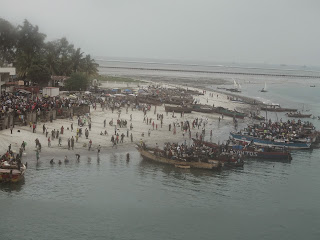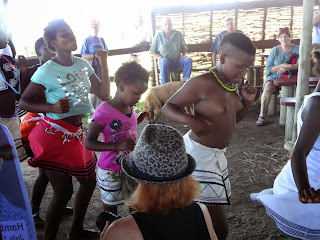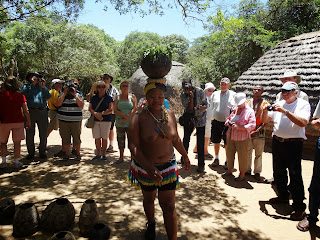Zanzibar, Tanzania
 |
| Map Showing Some of Our Ports of Call (Red Dots) |
Many have heard of Zanzibar, yet many more have
no clue where it is. It's an island off the coast of Tanzania, due east of Dar
es Salam. It was a spice island in the past and a collection point for slaves who were shipped throughout the world. Yearly, about 60,000 slaves left Zanzibar and
were sold mostly to the Arabian countries.
Zanzibar, for most of its history was ruled
by Arabian Sheiks or Sultans. In 1840 the Sultan of Oman was the richest man in
the world. A combination of money received for rare spices and payments to him
from the slave traders, gave this Sultan money
 |
| Nutmeg |
galore. One nutmeg nut sold in
London, England in 1840, for the price one would pay for a house in London at
the time. Just imagine in today's economy, a London house for a nutmeg. By the
way, each nutmeg tree delivers about 3000 nuts a year. The Sultan controlled
the trade. Zanzibar was his headquarters for all of East and South Africa.
Zanzibar has a unique location. The harbor
is deep all year round providing easy access for large ships. Zanzibar has a
historic town, Stone Town. In the colonial era, European and U.S. Embassies
were present in Stone Town. In the 1800’s Zanzibar was what Manhattan or Hong
Kong is today, the center of business. Anything coming off the large African
continent was shipped via Zanzibar. Large sailing vessels could not dock on the
East African coast. Reefs, sand banks and shallow harbors made loading
cumbersome. The lack of a large city with good facilities and European
oversight at the time gave Zanzibar the edge. While ruled by Arabian Sultans,
it was an economic powerhouse and the center of trade.
Slavery was just part of this trade. The
human misery it created was of no consequence to the merchants at the time. In
fact their trade, slavery, was proudly advertised on the front door of their
house with elaborate and stylized carvings. Zanzibar was also the supply store
that outfitted famous Africa explorers such as Livingston and many others. I
mention Livingston because he was the man, after he returned to England, who
spoke out against slavery in a big way. Due to him and many others, slavery was
officially abolished in the year 1873 in Zanzibar. Good, no more slavery,
right? Well, did you know that slavery was only made unlawful in Saudi Arabia
as late as 1965? You read right, 1965, with a moratorium, a phasing out period
until 1975. And these slaves were secretly supplied by Zanzibar. Only after
1975 did it become an offense to trade or possess slaves in Saudi Arabia. I
wonder if it is actively enforced even today. Who would know if a woman held in
a harem is a slave or not? Think about that! Sure makes me wonder.
Well that was Zanzibar two centuries ago.
Today Zanzibar is geared towards tourists. Gone are the unique naval advantages
it had, gone are the monopolies of the spice trade and Zanzibar is no longer
ruled by a Sultan but belongs to the Republic of Tanzania. Tourism is now the main source of income
for most if not all the people on this Island.
Carol and I participated and helped
the local economy in this way. Jean and Ross Copas found an excursion via the
Internet that sounded promising. A dhow ride,
 |
| Dhows in the Harbour When we Docked |
snorkeling, lunch, drinks,
sandbars, coral reefs, nature and a guided walk through Stone Town, all for
just $ 97 for the day, per person. Sounds good? It was even better! This day
was a fantastic day! Nothing was artificial, we lived the real thing; it was
all of the things I spelled out and more.
A former British lawyer, Eleanor, the owner of Safari Blue, delivered as
promised. She herself was part of the outing and her crews and dhows were authentic
and happy. Eleanor runs a good business.
Six of us were picked up at the ship in a first
class, modern bus, transported to a secluded beach to be transferred into
dhows waiting off shore. We were given flippers and snorkels and then were
guided across the flat (low tide) beach to climb into the dhows. With the help
of the crew and an outboard motor we arrived a bit later to a spot that had an
amazing variety of corals and marine life. The instructions to snorkel were
easy to follow and the sights of life below the surface were just stunning. Nobody
wanted to leave but the idea of a good lunch convinced us to abandon this great
snorkeling spot.
 |
| Poster of a Dhow on an Idyllic Beach |
Before we went ashore on an uninhabited
island for our mid day feast however, we beached ourselves on a huge sand bank,
maybe an atoll, just so we could later see how much the tide would cover this
barren spot later. We had a choice of assorted fruits as a snack and all the
non alcoholic drinks one would want. We watched the tide come in for a little
while then scrambled back on board the dhows. We had lunch next.
Lunch was a rare event. It was a delight
for the eyes, for the stomach and had a surreal, true atmosphere. Rugged,
cloth covered tables and benches were placed on the beach, under the trees, in
the deep shadows. A mild wind blew across the water, pleasantly cooling us off.
No flies to bother us. The food was amazing; it was African food at its best. BBQ
lobster tails, king fish, tuna, chicken, curried rice, polenta, vegetables and
again all the drinks one could drink, this time including beer or wine.
The dessert was really different. Assortments
of local fruits were offered to us. Not only were they offered, but it was
explained how to best prepare and eat them. There were red bananas, screw
mangos, jack fruit, passion fruit, dates, Turkish delight etc. All the personnel
during lunch were employed by Eleanor. Her people were happy, smiled easily and
seemed content. Eleanor paid them well and they could all keep and share the
food we, the clients, did not eat.
Michael, Eleanor's beau, told us that years
ago Eleanor's first husband was killed, shot dead, by locals from Zanzibar. They
killed him because his unfair business dealings with his employees which upset
the local tradition. The killers were never found, even though they shot him in
front of Eleanor and their two young children at the time. Africa can still be
wild and brutal. The locals, however, did not count on the toughness of the
British. Eleanor, despite the death of her husband, took over the business and
has been running it successfully for decades now. She still treats her
employees well, too.
After lunch we went back to the main Island
for a short, guided visit to Stone Town in Port Victoria. Our guide was the
same man who also guided Prince Charles through Stone Town. This man certainly
knew this town and history well. With a friendly attitude and many stories about
the area, our guide made the tour a delight. We never felt rushed, nor felt
lost in the large crowds of tourists all around us. After maybe an hour we all
went back to our cruise ship. It was a delightful, informative day that gave me
a real insight of other people's lives in a foreign land.
If
you ever go to Zanzibar seek out Safari Blue, you can Google it.
































































